| Ghastly Gastropoda: Top Ten Predatory Slugs and Snails |
Though far from the sophistication of the related cephalopods, the Gastropoda - slugs and snails - comprise
nearly 90% of the phylum Mollusca, and vary dramatically from the crawling leaf-eaters in your backyard to
eerie aliens of the deep sea abyss. Naturally, many of these slow-moving, slow-thinking slimers are strictly
carnivorous, and if you're wondering just how a snail could be much of a threat to anything, you obviously
haven't read enough of this website.
nearly 90% of the phylum Mollusca, and vary dramatically from the crawling leaf-eaters in your backyard to
eerie aliens of the deep sea abyss. Naturally, many of these slow-moving, slow-thinking slimers are strictly
carnivorous, and if you're wondering just how a snail could be much of a threat to anything, you obviously
haven't read enough of this website.
| Written by Jonathan Wojcik |
| #10 - Worm-eating Slugs |
The presence of a shell is the only real line between "slug" and "snail," a line blurred by species with varying
degrees of vestigial or even internalized shells. Arguably oxymoronic, the curious "shelled slugs" or Testacella
are protected by only a thumbnail-like plate on the end of their rump. Though thought to be quite plentiful
throughout the world, these burrowing predators lurk deep beneath the ground and are very rarely seen by
man. Their diet consists almost entirely of earthworms, which they slurp whole into highly expandable mouths.
degrees of vestigial or even internalized shells. Arguably oxymoronic, the curious "shelled slugs" or Testacella
are protected by only a thumbnail-like plate on the end of their rump. Though thought to be quite plentiful
throughout the world, these burrowing predators lurk deep beneath the ground and are very rarely seen by
man. Their diet consists almost entirely of earthworms, which they slurp whole into highly expandable mouths.
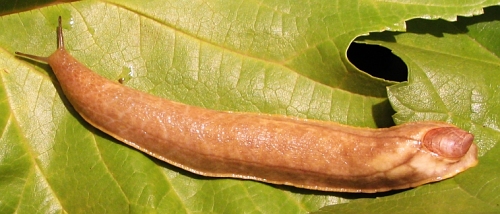
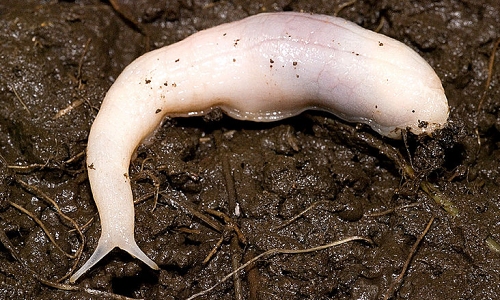
A similar slimeball is the properly shell-free ghost slug, Selenochlamys ysbryda, discovered in 2006 and named
in 2008. Like testacella, these creatures are strictly subterranean, but show even further adaptation to this
lifestyle with their colorless bodies and complete lack of eyes.
in 2008. Like testacella, these creatures are strictly subterranean, but show even further adaptation to this
lifestyle with their colorless bodies and complete lack of eyes.
| #9 - Wolf Snails |
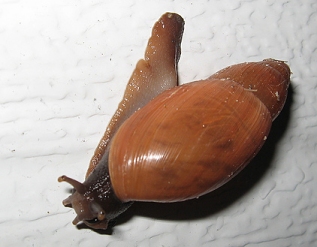
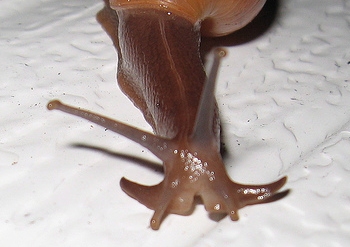
When giant, imported African snails threatened the fragile ecosystem of Hawaii, Tahiti and other pacific islands,
the rosy wolf snail was deliberately imported and released against all better judgement as natural pest control.
Unfortunately - and to many biologists, predictably - these ravenous cannibals had a bigger appetite for the
defenseless native tree snails. Within a decade or two, the colorful tree snails of Hawaii and Tahiti were
reduced from over a hundred species to only a dozen, most of which are nearing extinction themselves...and
the African snails? Still at large.
the rosy wolf snail was deliberately imported and released against all better judgement as natural pest control.
Unfortunately - and to many biologists, predictably - these ravenous cannibals had a bigger appetite for the
defenseless native tree snails. Within a decade or two, the colorful tree snails of Hawaii and Tahiti were
reduced from over a hundred species to only a dozen, most of which are nearing extinction themselves...and
the African snails? Still at large.
Adapted to prey exclusively on all other slugs and snails including their own species, wolf snails use their long,
thin bodies to invade the shells of larger prey while smaller snails are simply swallowed shell and all. Their
elongated, tentacle-like upper lips are employed like a metal detector, packed with sensors finely tuned to
follow a fresh slime trail.
thin bodies to invade the shells of larger prey while smaller snails are simply swallowed shell and all. Their
elongated, tentacle-like upper lips are employed like a metal detector, packed with sensors finely tuned to
follow a fresh slime trail.
| #8 - Janthina Snails |
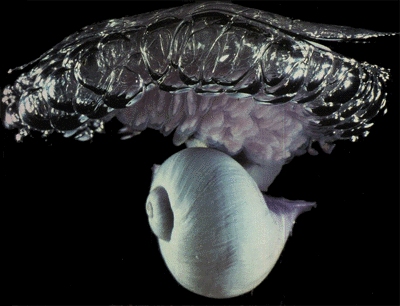
We're now getting into the marine gastropods, which dwarf the slugs and snails of the land by several
thousand species. Among them, the violet sea snails or Janthina snails, which live their entire adult lives
hanging upside-down from an air-filled bubble raft formed of chitin, the same substance in an arthropod's
exoskeleton and an element of mollusk shells. Helpless but to ride the sea's current, these creatures count on
bumping into other freaky floaters like the infamous Portuguese Man O' War, a colonial organism whose
tentacles can reach excess of a hundred feet. The Man O' War packs a notoriously dangerous sting, but does
nothing to perturb these slimy, spineless pirates, who use their long and powerful necks to rip pieces off their
gelatinous prey.
thousand species. Among them, the violet sea snails or Janthina snails, which live their entire adult lives
hanging upside-down from an air-filled bubble raft formed of chitin, the same substance in an arthropod's
exoskeleton and an element of mollusk shells. Helpless but to ride the sea's current, these creatures count on
bumping into other freaky floaters like the infamous Portuguese Man O' War, a colonial organism whose
tentacles can reach excess of a hundred feet. The Man O' War packs a notoriously dangerous sting, but does
nothing to perturb these slimy, spineless pirates, who use their long and powerful necks to rip pieces off their
gelatinous prey.
| #5 - Cone Snails |

Many carnivorous gastropods are limited to whatever prey can be chased down at, well, a snail's pace, but the
Conidae have developed a sophisticated technique for ensnaring even far speedier fish and crustacea. Their
chitinous teeth have been modified from blunt, rasping and chewing tools to a series of barbed, venomous
needles, each connected to a long, thin cable of tissue. These "harpoons" can be fired with blinding speed,
injecting prey with toxins and reeling them back in to be engulfed by the snail's trumpet-like mouth. Extremely
high-potency venom ensures even the most energetic of prey are subdued almost instantly, and makes
several species dangerous - even lethal - to large mammals like ourselves.
Conidae have developed a sophisticated technique for ensnaring even far speedier fish and crustacea. Their
chitinous teeth have been modified from blunt, rasping and chewing tools to a series of barbed, venomous
needles, each connected to a long, thin cable of tissue. These "harpoons" can be fired with blinding speed,
injecting prey with toxins and reeling them back in to be engulfed by the snail's trumpet-like mouth. Extremely
high-potency venom ensures even the most energetic of prey are subdued almost instantly, and makes
several species dangerous - even lethal - to large mammals like ourselves.

| Photo by Kerry Matz at National Geographic |
| #4 - Sea Angels |
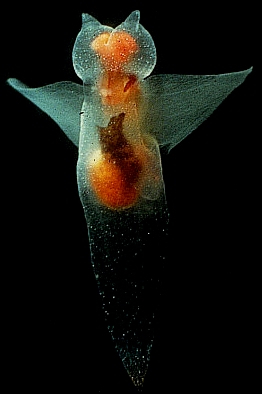
Last of our swimming snails, I've discussed Clione before in my guide to Pokemon, but these darling little
creatures deserve plenty more elaboration. With their wing-like fins, rounded heads and pinkish "hearts," it's
hard not to fall in love with these tiny, slimy fairies, who have earned such names as sea angel, ice angel and
even dancing ice princess. As their nicknames imply, they inhabit freezing waters near masses of sea ice. In
wintertime, these creatures thickly infest waters off the coast of japan, where they have unsurprisingly been
turned into children's icons.
creatures deserve plenty more elaboration. With their wing-like fins, rounded heads and pinkish "hearts," it's
hard not to fall in love with these tiny, slimy fairies, who have earned such names as sea angel, ice angel and
even dancing ice princess. As their nicknames imply, they inhabit freezing waters near masses of sea ice. In
wintertime, these creatures thickly infest waters off the coast of japan, where they have unsurprisingly been
turned into children's icons.
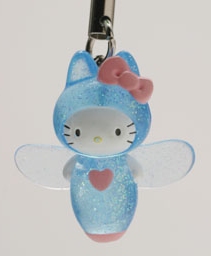
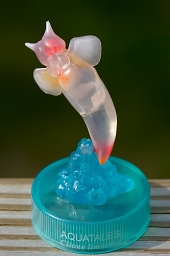

Now, we all know nature is more than just rainbows and pixie-dust, but perhaps no single animal demonstrates
the savagery of reality more poignantly than the sea angel, which preys almost exclusively on another,
shell-bearing species of swimming snail in spectacular fashion.
the savagery of reality more poignantly than the sea angel, which preys almost exclusively on another,
shell-bearing species of swimming snail in spectacular fashion.

Normally bobbing through the water at a lazy pace, our little angel springs into action the instant it detects its
preferred prey, transforming from fanciful fairy to Lovecraftian nightmare as a ring of long, barbed tentacles
spring from its bag-like head to tear the victim clean out of its shell. You know what we really need here? A
diagram. Can we get a diagram? Oh, awesome!
preferred prey, transforming from fanciful fairy to Lovecraftian nightmare as a ring of long, barbed tentacles
spring from its bag-like head to tear the victim clean out of its shell. You know what we really need here? A
diagram. Can we get a diagram? Oh, awesome!


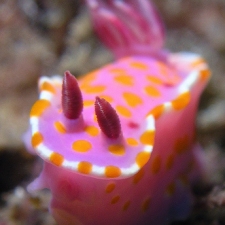
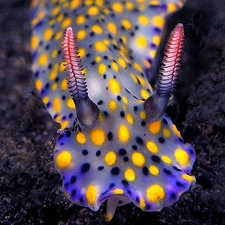
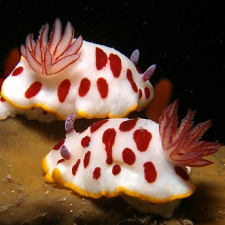
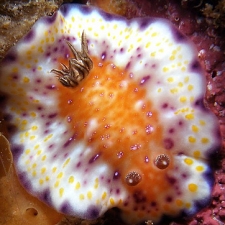

There is perhaps no flower that blooms on the land quite so breathtaking as some of the slimy slugs that creep
along the sea floor, whose colors in many cases are too vivid for photography to even reproduce. These
stunning images are only a scaled-down taste of Doug Deep's flickr gallery, with over 70 images that are not
to be missed; nor should you pass up this one. In fact, just put "nudibranch" in any image search engine.
These crawling clowns of the reef are named for their "nude" gills, the flower-like appendages that serve not
only as a breathing apparatus, but in many cases a defense mechanism. The eyes of Nudibranchs are
extremely simple and often invisible, but they navigate with a pair of highly sensitive rhinophores (slug noses)
that we can see as ear-like "antennae."
along the sea floor, whose colors in many cases are too vivid for photography to even reproduce. These
stunning images are only a scaled-down taste of Doug Deep's flickr gallery, with over 70 images that are not
to be missed; nor should you pass up this one. In fact, just put "nudibranch" in any image search engine.
These crawling clowns of the reef are named for their "nude" gills, the flower-like appendages that serve not
only as a breathing apparatus, but in many cases a defense mechanism. The eyes of Nudibranchs are
extremely simple and often invisible, but they navigate with a pair of highly sensitive rhinophores (slug noses)
that we can see as ear-like "antennae."
Our top three gastropoda all belong the Nudibranch group, so let's take a moment to
learn about them...
Oh, and weep in awe at nature's Majesty. That too.
learn about them...
Oh, and weep in awe at nature's Majesty. That too.
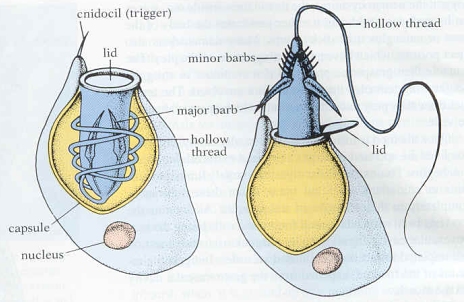
All of these venomous prey are members of the cnidaria, and deliver their toxins via nematocysts or "stinging
cells," but while cnidarians alone have developed these microscopic weapons, they are not the only animals to
wield them. By some mechanism still debated, many nudibranchs are able to attack and consume a variety of
stinging jellies without setting off their nematocysts, and by even more bewildering means, the cells are sorted
out from the rest of the meal and transported to the mollusk's tentacles for its own defense.
cells," but while cnidarians alone have developed these microscopic weapons, they are not the only animals to
wield them. By some mechanism still debated, many nudibranchs are able to attack and consume a variety of
stinging jellies without setting off their nematocysts, and by even more bewildering means, the cells are sorted
out from the rest of the meal and transported to the mollusk's tentacles for its own defense.

| BIOLOGY. |
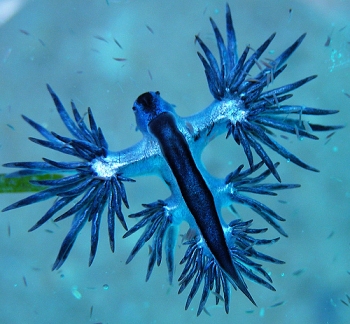
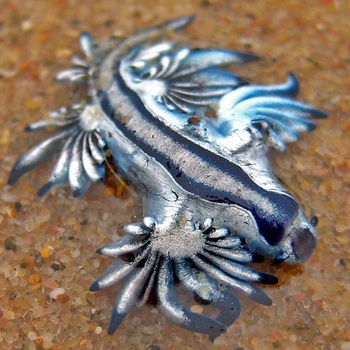
Nudibranchs of all shapes and colors are known to defend themselves with these pirated harpoons, but there
are few as unusual - or beautiful - as Glaucus atlanticus, sometimes called a "sea lizard." Why this gets stuck
with "lizard" and Clione with "angel" is anyone's guess, as Glaucus floats on feathery wings straight off a cherub.
are few as unusual - or beautiful - as Glaucus atlanticus, sometimes called a "sea lizard." Why this gets stuck
with "lizard" and Clione with "angel" is anyone's guess, as Glaucus floats on feathery wings straight off a cherub.
Like the Janthina above, it spends its adult life floating upside-down at the surface of the sea, preying on Man
O' Wars and various other sailors - even the far larger Janthina themselves. Though only six centimeters in
length, Glaucus can be far more dangerous than any of its prey, as its body appears to select and concentrate
only the most potent nematocysts from its meals.
O' Wars and various other sailors - even the far larger Janthina themselves. Though only six centimeters in
length, Glaucus can be far more dangerous than any of its prey, as its body appears to select and concentrate
only the most potent nematocysts from its meals.
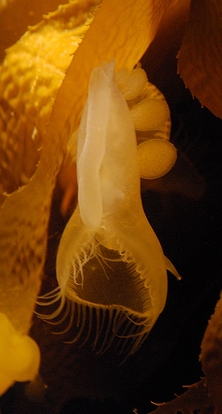
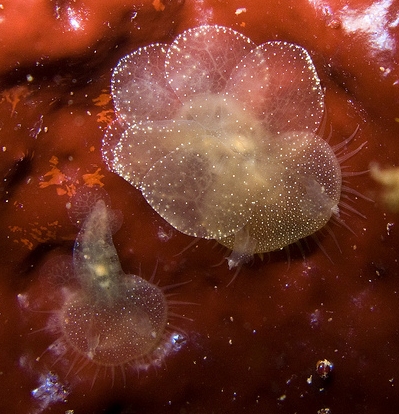
With its incredibly broad, flat, tentacle-lined "lips," the "Lion" nudibranch Melibe leonina transforms itself into an
underwater Venus Fly Trap, clinging to aquatic plants and holding its mouth in the current to trap small fish and
crustaceans. Check out a beautiful video!
underwater Venus Fly Trap, clinging to aquatic plants and holding its mouth in the current to trap small fish and
crustaceans. Check out a beautiful video!
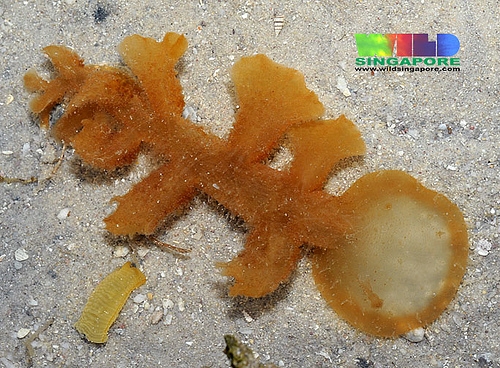
Other "hooded" Nudibranchs simply resemble clumps of seaweed themselves, or blend in perfectly with the
texture and color of surrounding sand. Rather than lying in wait, these varieties prefer to sneak up invisibly and
throw their hoods over unsuspecting creatures like a rubbery net.
texture and color of surrounding sand. Rather than lying in wait, these varieties prefer to sneak up invisibly and
throw their hoods over unsuspecting creatures like a rubbery net.

Of all these colorful creepers, one of the largest is Hexabranchus sanguineus, often called the "Spanish
Dancer" for its spectacular appearance when swimming. It feeds primarily on sea sponge, from which it
extracts defensive chemicals and modifies them on a molecular level to poison its own meat. Eating sponge
may not sound as exciting as some of our other entries, but keep in mind that sea sponge is still a form of
animal life.
Dancer" for its spectacular appearance when swimming. It feeds primarily on sea sponge, from which it
extracts defensive chemicals and modifies them on a molecular level to poison its own meat. Eating sponge
may not sound as exciting as some of our other entries, but keep in mind that sea sponge is still a form of
animal life.

| #6 - Pterotrachea |
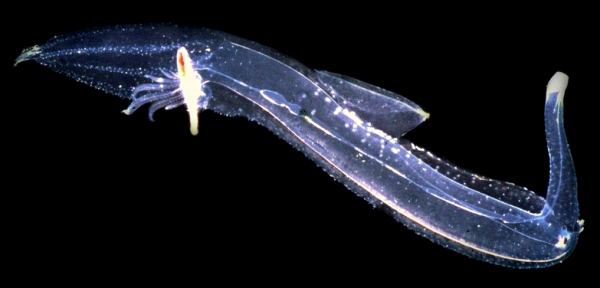
Another group of Holoplanktonic mollusk, genus Pterotrachea ("winged windpipe") are far larger transparent
swimmers with beady, tubular eyes and comical, anteater-like trunks. Larvae possess a classic, coiled snail
shell, but the shell is reduced to an internal pen-like spine or entirely absent by adulthood. With their neutral
buoyancy and a single, twisting fin, they can hover in the water with exceptional precision, not unlike the
physics of a helicopter.
At night, Pterotrachea usually swim with their eyes and trunks pointed downwards, searching for
bio-luminescent prey. By day, however, they swim on their backs (see photo), scanning for prey against the
sunlight above.
swimmers with beady, tubular eyes and comical, anteater-like trunks. Larvae possess a classic, coiled snail
shell, but the shell is reduced to an internal pen-like spine or entirely absent by adulthood. With their neutral
buoyancy and a single, twisting fin, they can hover in the water with exceptional precision, not unlike the
physics of a helicopter.
At night, Pterotrachea usually swim with their eyes and trunks pointed downwards, searching for
bio-luminescent prey. By day, however, they swim on their backs (see photo), scanning for prey against the
sunlight above.

Gastropods lack teeth as we know them, but most are armed with a radula, also present in the Cephalopods.
The radula is essentially a tongue completely covered in barbed plates, and is repeatedly curled and uncurled
to shave through food like an organic chainsaw. The radula is used by both carnivores and herbivores to rasp
away at their meals, but many Gastropoda have modified their feeding system for a variety of specialized diets.
The radula is essentially a tongue completely covered in barbed plates, and is repeatedly curled and uncurled
to shave through food like an organic chainsaw. The radula is used by both carnivores and herbivores to rasp
away at their meals, but many Gastropoda have modified their feeding system for a variety of specialized diets.

In this lovely shot by Seapy, we can see how much more menacing these animals look up close. What
resembles a set of teeth between the Freudian lips is the wicked, coiled radula, ready to saw through the flesh
of other swimming invertebrates. The eyes of Pterotrachea are thought to be the most advanced of any
gastropod and highly sophisticated among animals as a whole.
resembles a set of teeth between the Freudian lips is the wicked, coiled radula, ready to saw through the flesh
of other swimming invertebrates. The eyes of Pterotrachea are thought to be the most advanced of any
gastropod and highly sophisticated among animals as a whole.
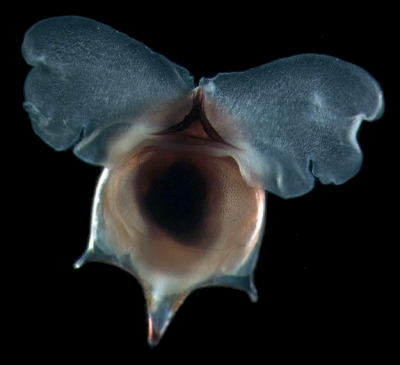
| #7 - Sea Butterflies |
Most sea-snails begin their lives as microscopic plankton, swimming through the water with tiny, flapping fins,
but the Thecosomata are holoplanktonic, meaning they remain this way for their entire lives. Different species
range from the surface of the sea to the deep abyss, and while many are passive plankton feeders (sweeping
whatever food they can into their cilia-lined throats), others spin large nets of mucus (in some cases over
twenty times their own width) to trap tiny crustaceans and other invertebrates. To feed, they simply collapse
the entire net into a noodle-like strand and slurp it back in, prey and all.
but the Thecosomata are holoplanktonic, meaning they remain this way for their entire lives. Different species
range from the surface of the sea to the deep abyss, and while many are passive plankton feeders (sweeping
whatever food they can into their cilia-lined throats), others spin large nets of mucus (in some cases over
twenty times their own width) to trap tiny crustaceans and other invertebrates. To feed, they simply collapse
the entire net into a noodle-like strand and slurp it back in, prey and all.
| #2 - Hooded Nudibranchs |
| #3 - The Spanish Dancer |
| #1 - The Sea Lizard |
While some Nudibranchs feed on sponges, plankton, plant life or whatever they can catch, there are thousands
of species who prey exclusively on stinging invertebrates like jellyfish, anemones and siphonophores.
of species who prey exclusively on stinging invertebrates like jellyfish, anemones and siphonophores.

| Mouth sequence by Cerberilla - visit for more amazing animal photography! |